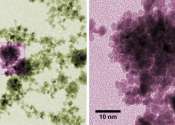Uranus' moon Titania
Like all of the Solar Systems' gas giants, Uranus has an extensive system of moons. In fact, astronomers can now account for 27 moons in orbit around Uranus. Of these, none are greater in size, mass, or surface area than ...

Like all of the Solar Systems' gas giants, Uranus has an extensive system of moons. In fact, astronomers can now account for 27 moons in orbit around Uranus. Of these, none are greater in size, mass, or surface area than ...
Space Exploration
Jul 6, 2015
4
34

Ever since the invention of the telescope four hundred years ago, astronomers have been fascinated by the gas giant of Jupiter. Between it's constant, swirling clouds, its many, many moons, and its Giant Red Spot, there are ...
Space Exploration
Jun 25, 2015
0
34

A trio of researchers working at Imperial College in London has created a new development technique for constructing nanofilms that not only requires less energy but results in a product that is able to stand up to organic ...

Researchers at the National Institute of Standards and Technology have developed a fast, simple process for making platinum 'nano-raspberries'—microscopic clusters of nanoscale particles of the precious metal. The berry-like ...
Bio & Medicine
Jun 9, 2015
0
881

Stanford University scientists have created a new carbon material that significantly boosts the performance of energy-storage technologies. Their results are featured on the cover of the journal ACS Central Science.
Nanomaterials
May 29, 2015
7
1121

An electrically conductive material, with layers resembling graphene (single sheet of graphite), was synthesized under mild conditions using a well-known molecule that allows good electronic coupling of nickel ions and organic ...
Nanomaterials
May 19, 2015
0
35

Scientists in South Korea have developed a new way to store energy that also offers a solution to a growing environmental problem.
Nanomaterials
May 18, 2015
0
154

A convenient procedure to visualize defects on graphene layers by mapping the surface of carbon materials with an appropriate contrast agent was introduced by a team of researchers from Zelinsky Institute of Organic Chemistry ...
Nanomaterials
May 8, 2015
0
22
It's easier to dissolve a sugar cube in a glass of water by crushing the cube first, because the numerous tiny particles cover more surface area in the water than the cube itself. In a way, the same principle applies to the ...
Nanophysics
May 4, 2015
0
55

How can the electrodes of batteries be made more efficient? In the journal Angewandte Chemie, American scientists describe a powerful approach that uses solvated graphene frameworks as the anode material. Assembled in a lithium ...
Materials Science
Mar 18, 2015
0
26